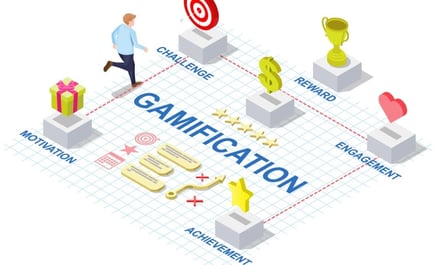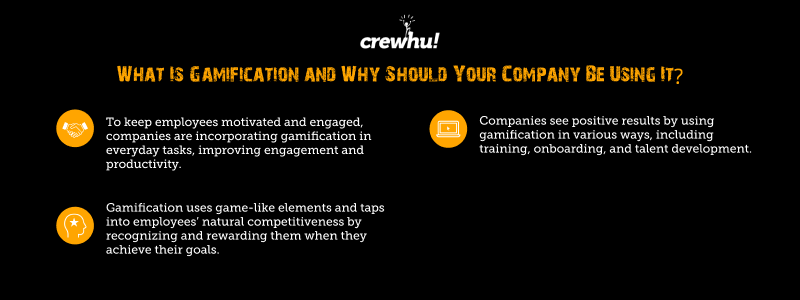What Is Gamification and Why Should Your Company Be Using It?


You may have heard about gamification and how it helps improve employee performance. But if not, you’re probably wondering, “What does gamification mean?”
Gamification has become a popular way for business owners and managers to motivate employees and keep them engaged with their tasks. When workers repeat the same mundane tasks over and over, they’re bound to get bored and lose morale.
In this era of remote and hybrid working, where digital chats have replaced deskside and lunch break conversations, the lack of physical connection with peers can result in employee disengagement and reduced productivity.
Gamifying tasks and projects keeps your employees motivated by making their work more fun and engaging. We’ll explore what gamification means, how it benefits organizations, examples of companies that have successfully used gamification for talent development, and how it can work for your organization.
What is gamification?
Gamification is the application of game elements and principles in non-game contexts – such as tasks and learning – to make them fun and engaging.
In the workplace, gamification aims at motivating workers and keeping them engaged. Companies can use gamification in different areas, such as recruitment, training, and everyday work.
Some common game elements implemented in the workplace include:
- Badges to display achievements
- Points as visual identifiers of progress in projects
- Leaderboards that foster friendly competition between teams or departments
- Rewards, such as gift cards and coupons, as recognition for goals achieved
Gamification works by tapping into our natural reward system. When employees achieve a goal or complete a task and receive a reward, their brains release dopamine, a feel-good hormone. When invited to perform the same action again, they’re likely to do it the same way – or even better – in the hope of achieving the same result. They will be more engaged and motivated to perform the task. Overall, this improves their productivity.
Benefits of gamification for talent development
Gamification benefits both the company and its employees. Increased motivation results in more productivity and, thus, improved returns for the organization. And employees will enjoy working and hitting their goals – and furthering their careers.
Here are ways gamification benefits talent development.
Increases engagement
Gamification plays a vital role in improving employee engagement at work. Many of us are naturally competitive, so when tasks are presented in a gamified way, workers are lured to complete the challenges and remain engaged throughout the task.
Upon completion, they get the feeling of accomplishment and self-motivation. In a survey, 83% of workers whose training was gamified felt motivated, while 61% of those who received non-gamified training felt unproductive and bored.
And when they achieve their goals, rewarding them for a job well done gives them a sense of belonging, increasing productivity.
Improves teamwork and collaboration
Teams can only succeed through effective collaboration, with no disengagement issues or lack of motivation.
Gamify projects by assigning points to every activity or achievement and tap the power of friendly competition by attaching rewards to points and rewarding the team with the highest score.
Friendly competition brings teams together and improves teamwork. Gamification also enhances collaboration and engagement for remote workers who might feel left out and unrecognized. It also encourages peer recognition between workers to foster good relationships and improve overall productivity.
Examples of gamification in talent development
Cisco’s social media training program
Cisco uses gamification to help employees build and develop their social media skills. The program has three certification levels—Specialist, Strategist, and Master—and four sub-specializations.
Depending on their job position, players learn how to use social media and leverage their skills. For example, HR representatives learn to reach potential candidates on LinkedIn, while sales managers learn to engage and convert customers on Facebook and Twitter.
As participants advance through the levels, they can earn points, perks, and badges. There are also online discussions, team challenges, recognitions, and testimonials.
NTT Data’s leadership training
NTT Data’s Samurai is a leadership development game that assesses employees’ skills through quizzes. Participants are offered customized training in a quest to attain certain levels and overcome specific challenges that teach time management, problem-solving, and negotiating skills, as they scale a virtual Mt. Fuji.
The game helps build collaboration as employees experience different virtual leadership situations. Participants learn to manage others and are awarded points for every level they achieve. They also receive peer recognition, direct feedback, and other rewards, such as Apple iPads.
The results? A 30% reduction in employee turnover, with half of the participants advancing to team leadership roles. Ultimately, the company saved money on recruiting and employee retention.
Kraft Technology Group’s professional development certification
Kraft Technology Group offers IT security, network support, and computer services to businesses to help them operate efficiently through the secure utilization of technology.
Due to the nature of work, training employees about security is a big priority. With help from CrewHu, Kraft developed a metric to evaluate employee performance by paying close attention to whether employees followed professional development requirements and achieved new certifications.
An employee who achieved a new certification for a partnership received CrewHu points they could cash in for prizes, badges, and other rewards. Gamifying the metrics motivated employees to pursue continuing certifications and grow their skills and careers.
Since it started tracking metrics with CrewHu, Kraft has maintained CSATs (customer satisfaction scores) at 99%, grown by 45% year-over-year, and doubled its revenue without adding more employees.
Gamify your metrics with CrewHu
Incorporating gaming elements into everyday tasks increases employee engagement and motivation. The results are a productive workforce, higher customer satisfaction scores (that we’ll help you proudly display), and increased revenues.
CrewHu is a customer satisfaction and employee recognition platform built to help MSPs like Kraft (and you) connect with their employees, recognize good work, and offer excellent customer interactions.
We’ll help you:
- Gamify your metrics
- Collect customer feedback automatically and display it using testimonial widgets
- Recognize your team and reward them for achieving their goals
Book a CrewHu demo today, and let us show you how you can gamify and improve performance to grow your business.






